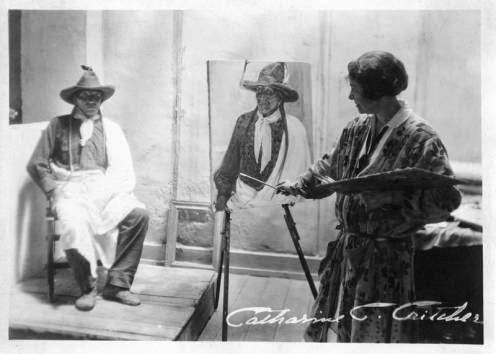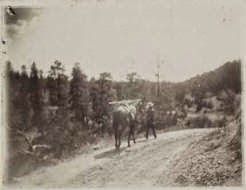“For heaven’s sake tell people what we have
found! Send some artists out here.” Bert Geer Phillips 1898
Blumenschein, Berninghaus, Couse, Phillips, Dunton (seated), Sharp
The first annual meeting of the Taos Society of
Artists was held July 15, 1915 at the home of Dr. & Mrs. Thomas Paul ‘Doc’
Martin in the main dining room. Dues for members and associates were decided to
be $5. Today their house is the Taos Inn, that very same dining room is the
wonderful restaurant Doc Martin’s. The Adobe Bar by the lobby is known as ‘The
Living Room of Taos’.
E.I Couse the first President of the Taos Society of Artists
Ernest Blumenschein
The following year the group again met on July
15, (1916) at Berninghaus’ studio.
Oscar Berninghaus
Bert Phillips
The original 6 members include:
Joseph Henry Sharp (1859-1953) first visits Taos
in 1893
Ernest Leonard Blumenschein (1874-1960) first
visits Taos in 1898
Bert Geer Phillips (1868-1956) first visits Taos
in 1898
Eanger Irving Couse (1866-1936) first visits
Taos in 1902
Oscar Edmund Berninghaus (1874-1952) first
visits Taos in 1899
William Herbert “Buck” Dunton (1878-1936) first
visits Taos in 1912
Joseph Sharp
Buck Dunton
Victor Higgins (1884-1949) to Taos in 1913 joins
in 1917
Walter Ufer (1876-1936) to Taos in 1914 joins in
1917
Taos Pueblo Governor Manuel Lujan w Victor Higgins
Walter Ufer
Julius Rolshoven (1858-1930) joins in 1918
Ernest Martin Hennings (1886-1956) to Taos in
1917, joins in 1924
Julius Rolshoven
E. Martin Hennings
The Taos Ten
Catherine Carter Crichter (1868-1964)
unanimously voted into the Society and the only female member joins in 1924
Kenneth
Miller Adams (1897-1966) joins in 1926
Kenneth Adams
Associate Members were made up mostly of artists
living in Santa Fe, they include:
Robert Henri (1865-1929)
Albert L. Groll (1866-1952)
Randall Davey (1887-1964)
B.J.O. Nordfelt (1878-1955)
Gustave Baumann (1881-1971)
Birger Sandzen (1871-1954)
John Sloan (1871-1951)
The Honorary Members included:
Edgar L. Hewitt (director of the Museum of Fine
Arts, Santa Fe/formerly the Museum of New Mexico Art Gallery)
Frank Springer (arts patron)
Taos Artists at the Don Fernando Hotel
Most of the artists at one time or another also
belonged to or were associates of other arts guilds, colonies and organizations.
Almost all had studied at one time or another in Europe.
“The very air of Taos country, its nearness to
big works of nature drives caution from man’s brain. He takes a chance. Perhaps
this has led the Taos painters to be original and to be so devoted to the
country and it’s people.” Victor Higgins 1917
A few years later Higgins ran for Mayor of Taos,
amazingly he lost by 12 votes!
The notion of these artists having romantic
visions through their paintings of Native Americans has been expressed a great
deal by other writers. I would like to add to this scenario that these men were
indeed romantics, their entire way of life of moving to an idealized west to
paint could be considered romantic or foolhardy,
but too, these men were gentle and kind of spirit towards their partners who
they adored. Much of the correspondence between these men and their wives is quite
romantic, much of their actions toward
their spouses is wonderfully romantic. Often their wives helped manage careers
of these men who were dedicating as much of their time as possible to creating
masterpieces.
That's Mrs. Dunton posing on horseback while Buck paints
The Taos Founders presented their vision to a
fascinated public who wanted more and couldn’t get enough. These artists
documented what they witnessed and what they were exposed to on a regular basis
in Taos, whether Native American ceremonies or day-to-day life of the Hispanic
people around them. Everything and anything was subject matter for these
painters. Most of what was being painted still exists to this day in and around
Taos. Buildings have changed, streets are paved and are named, the population
has grown, the way people dress has changed, yet the mountains remain reflected
in the magical shifting light under a sky of ‘Taos blue’, the cultural ceremonies
of the people and the daily struggles of living in a remote mountain town
remain.
Taos Plaza 1907
I have already mentioned in ‘part 1’ of this
story line that most of the artists did not stay in Taos during the harsh
winter months, eventually they do, but not early on, except for Phillips who
settles in Taos upon his arrival.
Artist easel in Winter
The first motivation for the artists to band
together may have been an exhibit at the Santa Fe Palace Museum in 1914. They
also had a second exhibit there in 1915 and for a while annually. The museum
may have slipped in a few Santa Fe artists along the way, motivating the Taos
Society to give a few of these artists Associate
status. Adding a few extra members also raised more funds with billing for
annual dues. The exhibitions were wildly successful drawing large crowds who
through the years seemed to have admiringly followed these homegrown artists
and looked forward to their annual exhibits in Santa Fe.
It’s also important to note that in Europe,
World War 1 was taking place during the years 1914-1918. How this affects true
American Painting and these artists is up to debate. It would seem that the
availability of European paintings would be scarce, and that there would be a
rising market for American paintings.
Taos Plaza onlookers with Taos Pueblo ceremonial Dancers 1908
The original goal was to gather a group of
paintings to be sent on a traveling schedule across the country through the support
of galleries, museums, art and arts minded organizations. At the outset sales
were brisk, yet towards the end the artists began adding contractual
obligations to the exhibitors asking that they guarantee at least one sale by
each artist. If the exhibitor could not sell to a client they would need to
purchase paintings outright for their own inventory.
The group exhibitions they sent on tour included
each artist’ very best work, absolute masterpieces. Each and every one of these
paintings would impress even the most casual visitor to any gallery. The paintings
themselves were often quite large. When
you consider the crating and shipping
paintings to each venue, this was quite an undertaking.
Ufer standing under the furniture sign, he has a tall hat on his head and is in profile looking left 1933
As for exhibiting their work in Taos during this
time period there were not as yet any galleries to exhibit in. There were no
art galleries in Taos prior to 1933. Thus the artists would welcome visitors to
their studios and homes where paintings were on display to collectors looking
to make purchases. Ufer may have been the one exception, on his studio door at
one point he posted “Keep Out TNT Explosive” in hopes of frightening off
curiosity seekers. Yet Ufer was known to talk to visitors into the night, lest
he not get any painting done, I believe he needed to focus, and this was the
best way he could imagine to divert distractions. The Taos artists seemed to
have had a unique understanding of what buyers would be able to take with them
upon purchasing. Each of them made what they referred to among themselves as
‘suitcase paintings’, sizes that could fit into the average luggage of
travelers of this time period.
Taos Pueblo represented in the Panama-(San
Diego) California Exposition brochure 1915-1917
In the early 1920’s the Fred Harvey tours begin
arriving in Taos with visitors requesting two things, a trip to the San
Geronimo de Taos Pueblo and a visit to an artist studio.
Phillips, Sharp and Couse collected blankets,
beaded bags, pottery, beaded moccasins, basketry, kachina dolls, and various
Native American artifacts to use as props. More than likely they also loaned
and traded each other for desired objects to complete authentic looking
scenarios.
Taos has been a trade route for more than a
few100 years, with the Mountain Men visiting and the roaming Native peoples who
followed the great migratory routes of wildlife. Much cultural material has
been brought into Taos for quite some time, in particular traded to the people
of Taos Pueblo. It’s not surprising to visit someone’s home there and see a
Northwest Coast artifact or a pair of beaded Ute moccasins.
In 1915 Mrs. Ellis and Mrs. Lina Scheurich (Governor Bent's Granddaughter) opened the
first art supply store making available to the local artists the very best art materials
being provided by the Royal Society of Art.
Taos Pueblo today with Taos Blue Sky above
It’s all about marketing, the Taos Founders
formed to enable these artists a way to market their paintings. Comparably this
could be thought of as a Taos Founders “Wild West Travelling Show” featuring
paintings on canvas rather than real live rodeo Cowboys and Indians on
horseback. By exhibiting paintings of a so-called ‘vanishing’ American West in
viably strong economic markets, winning various nationwide competitions adding
cache to and making their works more desirable, making Taos, New Mexico in the
Southwest a destination for visitors from all over the Country. None of this
would have been possible without a whole lot of dedicated hard work and truly
great talent.
Henry Balinck, Nicolai Fechin, Joseph Fleck, and
Leon Gaspard had all been blackballed. A number of reasons were given, yet the
most likely would have been the fact that they were selling paintings quite
profusely. In an 18 week time period Balinck had sold 16 paintings while in
Taos!
A great deal of research reading everything I
could get my hands on from scrapbooks to gallery catalogues to monographs and
everything in between has gone into these stories. I find that nothing has
really changed in Taos, or in any small town art colony. We struggle, we
quibble and bicker, we become territorial, along with horrific jealousies, all
of which are better left unsaid. At the end of the day making art and finding
the market for that art are after all, struggles enough.
Seated left to right: Bert Phillips, Mrs. Lucille
Harwood, daughter Helen Blumenschein Standing left to right: Oscar Berninghaus,
Woman?, Dr. Light, Walter Ufer, Leon Gaspard, Mrs. Lucille Couse, D.H.
Lawrence, Mrs. Lockwood, Mrs. Mary Blumenschein, Joseph Sharp, Kenneth Adams, Mabel Dodge Luhan, Mary
Austin. Tony Lujan, Ernest Blumenschein, D. Martinez Mote, Taos Pueblo woman
and 2 Taos Pueblo men
2015 marks the
100th anniversary of the formation of the Taos Society of Artists on July 15,
1915. Thank you for your interest, I hope that you will visit us
in Taos and wonder at what was past and show your support to the artists of
this art colony 75 miles north of Santa Fe.













































